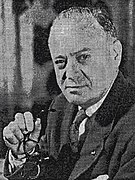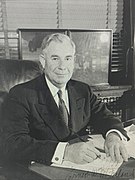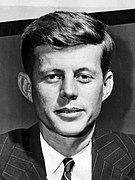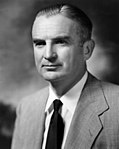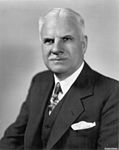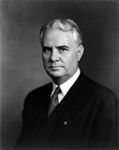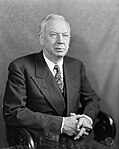The 1952 United States Senate elections was an election for the United States Senate which coincided with the election of Dwight D. Eisenhower to the presidency by a large margin. The 32 Senate seats of Class 1 were contested in regular elections, and three special elections were held to fill vacancies. The Republicans took control of the Senate by managing to make a net gain of two seats. However, Wayne Morse (R-OR) became an independent forcing Republicans to rely on Vice President Richard Nixon's tie-breaking vote, although Republicans maintained a 48–47–1 plurality. Throughout the next Congress, Republicans were able to restore their 49–46–1 majority. This was the third time, as well as second consecutive, in which a sitting Senate leader lost his seat.
| |||||||||||||||||||||||||||||||||||||
35 of the 96 seats in the United States Senate 49 seats needed for a majority | |||||||||||||||||||||||||||||||||||||
|---|---|---|---|---|---|---|---|---|---|---|---|---|---|---|---|---|---|---|---|---|---|---|---|---|---|---|---|---|---|---|---|---|---|---|---|---|---|
| |||||||||||||||||||||||||||||||||||||
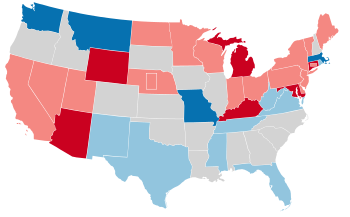 | |||||||||||||||||||||||||||||||||||||
| |||||||||||||||||||||||||||||||||||||
The 1952 United States Senate elections marked a significant shift in power, with the Republicans gaining control of the Senate by making a net gain of two seats.
This was the last time the Senate changed hands in a presidential election year until 1980 and the last time the Republicans won control of the Senate until 1980. As of 2020, this is the last time both houses simultaneously changed hands in a presidential year.[1]
Results summary edit
| 47 | 49 |
| Democratic | Republican |
Colored shading indicates party with largest share of that row.
| Parties | Total | ||||||||||||||||||||||||||||||||||||||||||||||||||||||||||||||||||||||||||||||||||||||||||||||||||
|---|---|---|---|---|---|---|---|---|---|---|---|---|---|---|---|---|---|---|---|---|---|---|---|---|---|---|---|---|---|---|---|---|---|---|---|---|---|---|---|---|---|---|---|---|---|---|---|---|---|---|---|---|---|---|---|---|---|---|---|---|---|---|---|---|---|---|---|---|---|---|---|---|---|---|---|---|---|---|---|---|---|---|---|---|---|---|---|---|---|---|---|---|---|---|---|---|---|---|---|
| Democratic | Republican | Other | |||||||||||||||||||||||||||||||||||||||||||||||||||||||||||||||||||||||||||||||||||||||||||||||||
| Last elections (1950) Before these elections | 49 | 47 | 0 | 96 | |||||||||||||||||||||||||||||||||||||||||||||||||||||||||||||||||||||||||||||||||||||||||||||||
| Not up | 35 | 26 | 0 | 61 | |||||||||||||||||||||||||||||||||||||||||||||||||||||||||||||||||||||||||||||||||||||||||||||||
| Up | 14 | 21 | — | 35 | |||||||||||||||||||||||||||||||||||||||||||||||||||||||||||||||||||||||||||||||||||||||||||||||
| Class 1 (1946→1952) | 13 | 19 | — | 32 | |||||||||||||||||||||||||||||||||||||||||||||||||||||||||||||||||||||||||||||||||||||||||||||||
| Special: Class 2 | 1 | 1 | — | 2 | |||||||||||||||||||||||||||||||||||||||||||||||||||||||||||||||||||||||||||||||||||||||||||||||
| Special: Class 3 | 0 | 1 | — | 1 | |||||||||||||||||||||||||||||||||||||||||||||||||||||||||||||||||||||||||||||||||||||||||||||||
| Incumbent retired | 2 | 2 | — | 4 | |||||||||||||||||||||||||||||||||||||||||||||||||||||||||||||||||||||||||||||||||||||||||||||||
| Held by same party | 1 | 2 | — | 3 | |||||||||||||||||||||||||||||||||||||||||||||||||||||||||||||||||||||||||||||||||||||||||||||||
| Replaced by other party |  1 Democrat replaced by 1 Democrat replaced by  1 Republican 1 Republican | — | 1 | ||||||||||||||||||||||||||||||||||||||||||||||||||||||||||||||||||||||||||||||||||||||||||||||||
| Result | 1 | 3 | 0 | 4 | |||||||||||||||||||||||||||||||||||||||||||||||||||||||||||||||||||||||||||||||||||||||||||||||
| Incumbent ran | 12 | 19 | — | 31 | |||||||||||||||||||||||||||||||||||||||||||||||||||||||||||||||||||||||||||||||||||||||||||||||
| Won re-election | 6 | 14 | — | 20 | |||||||||||||||||||||||||||||||||||||||||||||||||||||||||||||||||||||||||||||||||||||||||||||||
| Lost re-election |  4 Republicans replaced by 4 Republicans replaced by  4 Democrats 4 Democrats 5 Democrats replaced by 5 Democrats replaced by  5 Republicans 5 Republicans | — | 9 | ||||||||||||||||||||||||||||||||||||||||||||||||||||||||||||||||||||||||||||||||||||||||||||||||
| Lost renomination but held by same party | 1 | 1 | — | 2 | |||||||||||||||||||||||||||||||||||||||||||||||||||||||||||||||||||||||||||||||||||||||||||||||
| Result | 11 | 20 | 0 | 31 | |||||||||||||||||||||||||||||||||||||||||||||||||||||||||||||||||||||||||||||||||||||||||||||||
| Total elected | 12 | 23 | 0 | 35 | |||||||||||||||||||||||||||||||||||||||||||||||||||||||||||||||||||||||||||||||||||||||||||||||
| Net change |  2 2 |  2 2 |  | 2 | |||||||||||||||||||||||||||||||||||||||||||||||||||||||||||||||||||||||||||||||||||||||||||||||
| Nationwide vote | 21,236,793 | 24,665,569 | 1,534,837 | 47,437,199 | |||||||||||||||||||||||||||||||||||||||||||||||||||||||||||||||||||||||||||||||||||||||||||||||
| Share | 44.77% | 52.00% | 3.24% | 100% | |||||||||||||||||||||||||||||||||||||||||||||||||||||||||||||||||||||||||||||||||||||||||||||||
| Result | 47 | 49 | 0 | 96 | |||||||||||||||||||||||||||||||||||||||||||||||||||||||||||||||||||||||||||||||||||||||||||||||
Source: Clerk of the U.S. House of Representatives[2]
Gains, losses and holds edit
Retirements edit
One Republican and one Democrat retired instead of seeking re-election. One Republican and one Democrat also retired instead of finishing the unexpired term.
| State | Senator | Replaced by |
|---|---|---|
| Connecticut (special) | William A. Purtell | Prescott Bush |
| Maryland | Herbert O'Conor | J. Glenn Beall |
| Nebraska (special) | Fred A. Seaton | Dwight Griswold |
| Texas | Tom Connally | Price Daniel |
Defeats edit
Four Republicans and five Democrats sought re-election, and one Republican and one Democrat also sought election to run to finish the unexpired term or in the six-year term but lost in the primary or general election.
Post-election changes edit
Change in composition edit
Before the elections edit
Going into the November elections.
| D1 | D2 | D3 | D4 | D5 | D6 | D7 | D8 | ||
| D18 | D17 | D16 | D15 | D14 | D13 | D12 | D11 | D10 | D9 |
| D19 | D20 | D21 | D22 | D23 | D24 | D25 | D26 | D27 | D28 |
| D38 Fla. Ran | D37 Conn. (reg) Ran | D36 Ariz. Ran | D35 | D34 | D33 | D32 | D31 | D30 | D29 |
| D39 Ky. (sp) Ran | D40 Md. Ran | D41 Mich. (sp) Mich. (reg) Ran | D42 Miss. Ran | D43 N.M. Ran | D44 R.I. Ran | D45 Tenn. Ran | D46 Texas Retired | D47 Va. Ran | D48 W.Va. Ran |
| Majority → | D49 Wyo. Ran | ||||||||
| R39 N.J. Ran | R40 N.Y. Ran | R41 N.D. Ran | R42 Ohio Ran | R43 Pa. Ran | R44 Utah Ran | R45 Vt. Ran | R46 Wash. Ran | R47 Wis. Ran | |
| R38 Nev. Ran | R37 Neb. (sp) Retired | R36 Neb. (reg) Ran | R35 Mont. Ran | R34 Mo. Ran | R33 Minn. Ran | R32 Mass. Ran | R31 Maine Ran | R30 Ind. Ran | R29 Del. Ran |
| R19 | R20 | R21 | R22 | R23 | R24 | R25 | R26 | R27 Calif. Ran | R28 Conn. (sp) Retired |
| R18 | R17 | R16 | R15 | R14 | R13 | R12 | R11 | R10 | R9 |
| R1 | R2 | R3 | R4 | R5 | R6 | R7 | R8 | ||
Results of the elections edit
| D1 | D2 | D3 | D4 | D5 | D6 | D7 | D8 | ||
| D18 | D17 | D16 | D15 | D14 | D13 | D12 | D11 | D10 | D9 |
| D19 | D20 | D21 | D22 | D23 | D24 | D25 | D26 | D27 | D28 |
| D38 N.M. Re-elected | D37 Miss. Re-elected | D36 Fla. Re-elected | D35 | D34 | D33 | D32 | D31 | D30 | D29 |
| D39 R.I. Re-elected | D40 Tenn. Hold | D41 Texas Hold | D42 Va. Re-elected | D43 W.Va. Re-elected | D44 Mass. Gain | D45 Mo. Gain | D46 Mont. Gain | D47 Wash. Gain | R49 Wyo. Gain |
| Majority → | |||||||||
| R39 Ohio Re-elected | R40 Pa. Re-elected | R41 Utah Re-elected | R42 Vt. Re-elected | R43 Wis. Re-elected | R44 Ariz. Gain | R45 Conn. (reg) Gain | R46 Ky. (sp) Gain[c] | R47 Md. Gain | R48 Mich. (sp) Mich. (reg) Gain[c] |
| R38 N.D. Re-elected | R37 N.Y. Re-elected | R36 N.J. Re-elected | R35 Nev. Re-elected | R34 Neb. (sp) Hold | R33 Neb. (reg) Re-elected | R32 Minn. Re-elected | R31 Maine Hold | R30 Ind. Re-elected | R29 Del. Re-elected |
| R19 | R20 | R21 | R22 | R23 | R24 | R25 | R26 | R27 Calif. Re-elected | R28 Conn. (sp) Hold |
| R18 | R17 | R16 | R15 | R14 | R13 | R12 | R11 | R10 | R9 |
| R1 | R2 | R3 | R4 | R5 | R6 | R7 | R8 | ||
Beginning of the next Congress edit
| D1 | D2 | D3 | D4 | D5 | D6 | D7 | D8 | ||
| D18 | D17 | D16 | D15 | D14 | D13 | D12 | D11 | D10 | D9 |
| D19 | D20 | D21 | D22 | D23 | D24 | D25 | D26 | D27 | D28 |
| D38 | D37 | D36 | D35 | D34 | D33 | D32 | D31 | D30 | D29 |
| D39 | D40 | D41 | D42 | D43 | D44 | D45 | D46 | D47 | I1 Ore. Changed |
| Majority using VP's vote ↓ | |||||||||
| R39 | R40 | R41 | R42 | R43 | R44 | R45 | R46 | R47 | R48 |
| R38 | R37 | R36 | R35 | R34 | R33 | R32 | R31 | R30 | R29 |
| R19 | R20 | R21 | R22 | R23 | R24 | R25 | R26 | R27 | R28 |
| R18 | R17 | R16 | R15 | R14 | R13 | R12 | R11 | R10 | R9 |
| R1 | R2 | R3 | R4 | R5 | R6 | R7 | R8 | ||
| Key |
|
|---|
Race summaries edit
Special elections during the 82nd Congress edit
In these special elections the winners were seated before January 3, 1953; ordered by election date, then state.
| State | Incumbent | Results | Candidates | ||
|---|---|---|---|---|---|
| Senator | Party | Electoral history | |||
| Connecticut (Class 3) | William A. Purtell | Republican | 1952 (Appointed) | Interim appointee retired to run for the Class 1 seat. New senator elected November 4, 1952. Republican hold. |
|
| Kentucky (Class 2) | Thomas R. Underwood | Democratic | 1951 (Appointed) | Interim appointee lost election. New senator elected November 4, 1952. Republican gain. |
|
| Michigan (Class 1) | Blair Moody | Democratic | 1951 (Appointed) | Interim appointee lost election. New senator elected November 4, 1952. Republican gain. Winner was also elected to the next term; see below. |
|
| Nebraska (Class 2) | Fred A. Seaton | Republican | 1951 (Appointed) | Interim appointee retired. New senator elected November 4, 1952. Republican hold. |
|
Races leading to the 83rd Congress edit
In these general elections, the winner was seated on January 3, 1953; ordered by state.
All of the elections involved the Class 1 seats.
| State | Incumbent | Results | Candidates | ||
|---|---|---|---|---|---|
| Senator | Party | Electoral history | |||
| Arizona | Ernest McFarland | Democratic | 1940 1946 | Incumbent lost re-election. New senator elected. Republican gain. |
|
| California | William Knowland | Republican | 1945 (Appointed) 1946 (special) 1946 | Incumbent re-elected. |
|
| Connecticut | William Benton | Democratic | 1949 (Appointed) 1950 (special) | Incumbent lost re-election. New senator elected. Republican gain. |
|
| Delaware | John J. Williams | Republican | 1946 | Incumbent re-elected. |
|
| Florida | Spessard Holland | Democratic | 1946 (Appointed) 1946 | Incumbent re-elected. |
|
| Indiana | William E. Jenner | Republican | 1944 (special) 1944 (Retired) 1946 | Incumbent re-elected. |
|
| Maine | Owen Brewster | Republican | 1940 1946 | Incumbent lost renomination. New senator elected. Republican hold. Incumbent resigned December 31, 1952. |
|
| Maryland | Herbert O'Conor | Democratic | 1946 | Incumbent retired. New senator elected. Republican gain. |
|
| Massachusetts | Henry Cabot Lodge Jr. | Republican | 1936 1942 1944 (Resigned) 1946 | Incumbent lost re-election. New senator elected. Democratic gain. |
|
| Michigan | Blair Moody | Democratic | 1951 (Appointed) | Interim appointee lost election. New senator elected. Republican gain Winner was also elected to finish the term; see above. |
|
| Minnesota | Edward J. Thye | Republican | 1946 | Incumbent re-elected. |
|
| Mississippi | John C. Stennis | Democratic | 1947 (special) | Incumbent re-elected. |
|
| Missouri | James P. Kem | Republican | 1946 | Incumbent lost re-election. New senator elected. Democratic gain. |
|
| Montana | Zales Ecton | Republican | 1946 | Incumbent lost re-election. New senator elected. Democratic gain. |
|
| Nebraska | Hugh A. Butler | Republican | 1940 1946 | Incumbent re-elected. |
|
| Nevada | George W. Malone | Republican | 1946 | Incumbent re-elected. |
|
| New Jersey | H. Alexander Smith | Republican | 1944 (special) 1946 | Incumbent re-elected. |
|
| New Mexico | Dennis Chávez | Democratic | 1935 (Appointed) 1936 (special) 1940 1946 | Incumbent re-elected. |
|
| New York | Irving Ives | Republican | 1946 | Incumbent re-elected. |
|
| North Dakota | William Langer | Republican | 1940 1946 | Incumbent re-elected. |
|
| Ohio | John W. Bricker | Republican | 1946 | Incumbent re-elected. |
|
| Pennsylvania | Edward Martin | Republican | 1946 | Incumbent re-elected. |
|
| Rhode Island | John Pastore | Democratic | 1950 (special) | Incumbent re-elected. |
|
| Tennessee | Kenneth McKellar | Democratic | 1916 1922 1928 1934 1940 1946 | Incumbent lost renomination. New senator elected. Democratic hold. |
|
| Texas | Tom Connally | Democratic | 1928 1934 1940 1946 | Incumbent retired. New senator elected. Democratic hold. |
|
| Utah | Arthur V. Watkins | Republican | 1946 | Incumbent re-elected. |
|
| Vermont | Ralph Flanders | Republican | 1946 (Appointed) 1946 (special) 1952 | Incumbent re-elected. |
|
| Virginia | Harry F. Byrd | Democratic | 1933 (Appointed) 1933 (special) 1934 1940 1946 | Incumbent re-elected. |
|
| Washington | Harry P. Cain | Republican | 1946 1946 (Appointed) | Incumbent lost re-election. New senator elected. Democratic gain. |
|
| West Virginia | Harley M. Kilgore | Democratic | 1940 1946 | Incumbent re-elected. |
|
| Wisconsin | Joseph McCarthy | Republican | 1946 | Incumbent re-elected. |
|
| Wyoming | Joseph C. O'Mahoney | Democratic | 1933 (Appointed) 1934 1940 1946 | Incumbent lost re-election. New senator elected. Republican gain. |
|
Closest races edit
Twenty races had a margin of victory under 10%:
| State | Party of winner | Margin |
|---|---|---|
| Michigan | Republican (flip) | 1.6% |
| Montana | Democratic (flip) | 2.19% |
| New Mexico | Democratic | 2.24% |
| Arizona | Republican (flip) | 2.6%[d] |
| Connecticut (special) | Republican | 2.7% |
| Massachusetts | Democratic (flip) | 2.99% |
| Kentucky (special) | Republican (flip) | 3.0% |
| Wyoming | Republican (flip) | 3.2% |
| Nevada | Republican | 3.4% |
| Pennsylvania | Republican | 3.6% |
| Maryland | Republican (flip) | 5.0% |
| Indiana | Republican | 5.6% |
| West Virginia | Democratic | 7.2% |
| Missouri | Democratic (flip) | 8.05% |
| Connecticut | Republican (flip) | 8.12% |
| Utah | Republican | 8.52% |
| Wisconsin | Republican | 8.67% |
| Delaware | Republican | 9.0% |
| Ohio | Republican | 9.2% |
| Rhode Island | Democratic | 9.6% |
Arizona edit
 | |||||||||||||||||
| |||||||||||||||||
| Turnout |  82.28% (registered voters)[5] 82.28% (registered voters)[5] | ||||||||||||||||
|---|---|---|---|---|---|---|---|---|---|---|---|---|---|---|---|---|---|
| |||||||||||||||||
 County results Goldwater: 50-60% McFarland: 50–60% 60–70% 70–80% | |||||||||||||||||
| |||||||||||||||||
| Party | Candidate | Votes | % | |
|---|---|---|---|---|
| Republican | Barry Goldwater | 132,063 | 51.31 | |
| Democratic | Ernest McFarland (Incumbent) | 125,338 | 48.69 | |
| Majority | 6,725 | 2.62 | ||
| Turnout | 257,401 | 82.28 | ||
| Republican gain from Democratic | ||||
California edit
 | ||||||||||||||||||||
| ||||||||||||||||||||
| ||||||||||||||||||||
 County Results Knowland: 80–90% 90-100% | ||||||||||||||||||||
| ||||||||||||||||||||
This section needs expansion. You can help by adding to it. (July 2017) |
| Party | Candidate | Votes | % | ±% | |
|---|---|---|---|---|---|
| Republican | William Knowland (Incumbent) | 3,982,448 | 87.79 | +33.69% | |
| Progressive | Reuben W. Borough | 542,270 | 11.95 | N/A | |
| Write-in | Helen Gahagan Douglas | 11,812 | 0.26 | N/A | |
| Total votes | 4,536,530 | 100.00 | |||
| Republican hold | Swing | ||||
Connecticut edit
There were two elections on the same day due to the July 28, 1952 death of two-term Democrat Brien McMahon.
Republican businessman William Purtell was appointed August 29, 1952 to continue the class 3 term, pending a special election in which he was not a candidate. Purtell was already the Republican nominee in the regular election for the class 1 seat, a race he then won.
Connecticut (special) edit
 | |||||||||||||||||
| |||||||||||||||||
| |||||||||||||||||
 County results Ribicoff: 50–60% Bush: 50-60% 60-70% | |||||||||||||||||
| |||||||||||||||||
This section needs expansion. You can help by adding to it. (July 2017) |
| Party | Candidate | Votes | % | |
|---|---|---|---|---|
| Republican | Prescott Bush | 559,465 | 51.17 | |
| Democratic | Abraham A. Ribicoff | 530,505 | 48.52 | |
| Socialist | William J. Taft | 3,298 | 0.30 | |
| Majority | 28,960 | 2.65 | ||
| Turnout | 1,093,268 | 54.47 | ||
| Republican hold | ||||
Connecticut (regular) edit
 | |||||||||||||||||
| |||||||||||||||||
| |||||||||||||||||
Purtell: 40–50% 50–60% 60–70% 70–80% 80–90% Benton: 40–50% 50–60% 60–70% | |||||||||||||||||
| |||||||||||||||||
| Party | Candidate | Votes | % | |
|---|---|---|---|---|
| Republican | William A. Purtell | 573,854 | 52.48 | |
| Democratic | William Benton (Incumbent) | 485,066 | 44.36 | |
| Independent Republican | Vivien Kellems | 22,268 | 2.04 | |
| Socialist | Jasper McLevy | 12,279 | 1.12 | |
| Majority | 88,788 | 8.12 | ||
| Turnout | 1,093,467 | |||
| Republican gain from Democratic | ||||
Delaware edit
 | |||||||||||||||||
| |||||||||||||||||
| |||||||||||||||||
 County results Williams: 50–60% | |||||||||||||||||
| |||||||||||||||||
This section needs expansion. You can help by adding to it. (July 2017) |
| Party | Candidate | Votes | % | |
|---|---|---|---|---|
| Republican | John J. Williams (Incumbent) | 93,020 | 54.49 | |
| Democratic | Alexis I. du Pont Bayard | 77,685 | 45.51 | |
| Majority | 15,335 | 8.98 | ||
| Turnout | 170,705 | |||
| Republican hold | ||||
Florida edit
 | |||||||||||||||||
| |||||||||||||||||
| |||||||||||||||||
 County Results Holland: >90% | |||||||||||||||||
| |||||||||||||||||
| Party | Candidate | Votes | % | ±% | |
|---|---|---|---|---|---|
| Democratic | Spessard Holland (incumbent) | 616,665 | 99.82% | ||
| Write-ins | 1,135 | 0.18% | |||
| Total votes | 617,800 | 100.00% | |||
Indiana edit
 | |||||||||||||||||
| |||||||||||||||||
| |||||||||||||||||
 County results Jenner: 40–50% 50–60% 60–70% 70–80% Schricker: 40–50% 50–60% | |||||||||||||||||
| |||||||||||||||||
This section needs expansion. You can help by adding to it. (July 2017) |
| Party | Candidate | Votes | % | |
|---|---|---|---|---|
| Republican | William E. Jenner (Incumbent) | 1,020,605 | 52.44 | |
| Democratic | Henry F. Schricker | 911,169 | 46.82 | |
| Prohibition | Carl W. Thompson | 12,734 | 0.65 | |
| Progressive | Carl Leon Eddy | 891 | 0.05 | |
| Socialist Labor | John Marion Morris | 719 | 0.04 | |
| Majority | 109,436 | 5.62 | ||
| Turnout | 1,946,118 | |||
| Republican hold | ||||
Kentucky (special) edit
 | |||||||||||||||||
| |||||||||||||||||
| |||||||||||||||||
 County results Cooper: 50–60% 60–70% 70–80% 80–90% Underwood: 50–60% 60–70% 70–80% 80–90% | |||||||||||||||||
| |||||||||||||||||
This section needs expansion. You can help by adding to it. (July 2017) |
| Party | Candidate | Votes | % | |
|---|---|---|---|---|
| Republican | John Sherman Cooper | 494,576 | 51.51 | |
| Democratic | Thomas R. Underwood (incumbent) | 465,652 | 48.49 | |
| Majority | 28,924 | 3.02 | ||
| Turnout | 960,228 | |||
| Republican gain from Democratic | ||||
Maine edit
 | |||||||||||||||||||||||||||||||||||||
| |||||||||||||||||||||||||||||||||||||
| |||||||||||||||||||||||||||||||||||||
| |||||||||||||||||||||||||||||||||||||
This section needs expansion. You can help by adding to it. (July 2017) |
| Party | Candidate | Votes | % | |
|---|---|---|---|---|
| Republican | Frederick G. Payne | 139,205 | 58.70 | |
| Democratic | Roger P. Dube | 82,665 | 34.86 | |
| Independent Democratic | Earl S. Grant | 15,294 | 6.45 | |
| Majority | 56,540 | 23.84 | ||
| Turnout | 237,164 | |||
| Republican hold | ||||
Maryland edit
 | |||||||||||||||||
| |||||||||||||||||
| |||||||||||||||||
 County results Beall: 50–60% 60–70% Mahoney: 50–60% | |||||||||||||||||
| |||||||||||||||||
This section needs expansion. You can help by adding to it. (July 2017) |
| Party | Candidate | Votes | % | |
|---|---|---|---|---|
| Republican | J. Glenn Beall | 449,823 | 52.54 | |
| Democratic | George P. Mahoney | 406,370 | 47.46 | |
| Majority | 43,453 | 5.08 | ||
| Turnout | 856,193 | |||
| Republican gain from Democratic | ||||
Massachusetts edit
 | |||||||||||||||||
| |||||||||||||||||
| |||||||||||||||||
| |||||||||||||||||
| |||||||||||||||||
| Party | Candidate | Votes | % | |||
|---|---|---|---|---|---|---|
| Democratic | John F. Kennedy | 1,211,984 | 51.34 | |||
| Republican | Henry Cabot Lodge Jr. (Incumbent) | 1,141,247 | 48.35 | |||
| Socialist Labor | Thelma Ingersoll | 4,683 | 0.20 | |||
| Prohibition | Mark R. Shaw | 2,508 | 0.11 | |||
| None | Scattering | 3 | 0.00 | |||
| Majority | 70,737 | 3.0 | ||||
| Turnout | 2,360,425 | |||||
| Democratic gain from Republican | ||||||
Michigan edit
 | |||||||||||||||||
| |||||||||||||||||
| |||||||||||||||||
 County results Potter: 50–60% 60–70% 70–80% 80–90% Moody: 50–60% 60–70% | |||||||||||||||||
| |||||||||||||||||
There were two elections to the same seat on the same day due to the April 18, 1951 death of five-term Republican Arthur Vandenberg. Democratic journalist Blair Moody was appointed April 23, 1951 to continue the term pending a special election. The primary elections were held August 5, 1952.[8] Moody lost both the special and the regular elections to Republican congressman Charles E. Potter.
Michigan (special) edit
This section needs expansion. You can help by adding to it. (July 2017) |
| Party | Candidate | Votes | % | |
|---|---|---|---|---|
| Republican | Charles E. Potter | 1,417,032 | 51.24 | |
| Democratic | Blair Moody (Incumbent) | 1,347,705 | 48.73 | |
| Socialist Workers | Genora Dollinger | 819 | 0.03 | |
| None | Scattering | 160 | 0.01 | |
| Majority | 69,327 | 2.51 | ||
| Turnout | 2,765,716 | 43.40 | ||
| Republican gain from Democratic | ||||
Michigan (regular) edit
This section needs expansion. You can help by adding to it. (July 2017) |
| Party | Candidate | Votes | % | |
|---|---|---|---|---|
| Republican | Charles E. Potter | 1,428,352 | 50.63 | |
| Democratic | Blair Moody (Incumbent) | 1,383,416 | 49.04 | |
| Prohibition | LeRoy M. Lowell | 7,435 | 0.26 | |
| Socialist Labor | James Sim | 1,202 | 0.04 | |
| Socialist Workers | Genora Dollinger | 726 | 0.03 | |
| None | Scattering | 2 | 0.00 | |
| Majority | 44,936 | 1.59 | ||
| Turnout | 2,821,131 | 44.28 | ||
| Republican gain from Democratic | ||||
Minnesota edit
 | |||||||||||||||||
| |||||||||||||||||
| |||||||||||||||||
 County results Thye: 40–50% 50–60% 60–70% 70–80% 80–90% Carlson: 50–60% 60–70% | |||||||||||||||||
| |||||||||||||||||
This section needs expansion. You can help by adding to it. (July 2017) |
| Party | Candidate | Votes | % | |
|---|---|---|---|---|
| Republican | Edward J. Thye (Incumbent) | 785,649 | 56.63 | |
| Democratic (DFL) | Bill Carlson | 590,011 | 42.53 | |
| Progressive | Marian LeSueur | 7,917 | 0.57 | |
| Socialist Workers | Vincent R. Dunne | 3,842 | 0.28 | |
| Majority | 195,638 | 14.10 | ||
| Turnout | 1,387,419 | |||
| Republican hold | ||||
Mississippi edit
This section needs expansion. You can help by adding to it. (July 2017) |
| Party | Candidate | Votes | % | |
|---|---|---|---|---|
| Democratic | John C. Stennis (Incumbent) | 233,919 | 100.00 | |
| Democratic hold | ||||
Missouri edit
 | |||||||||||||||||
| |||||||||||||||||
| |||||||||||||||||
 County results Symington: 50–60% 60–70% 70–80% Kem: 50–60% 60–70% 70–80% 80–90% | |||||||||||||||||
| |||||||||||||||||
This section needs expansion. You can help by adding to it. (July 2017) |
| Party | Candidate | Votes | % | |
|---|---|---|---|---|
| Democratic | Stuart Symington | 1,008,521 | 53.99 | |
| Republican | James P. Kem (Incumbent) | 858,170 | 45.94 | |
| Progressive | Haven P. Perkins | 883 | 0.05 | |
| Socialist | Joseph G. Hodges | 219 | 0.01 | |
| Christian Nationalist | Christian Frederick | 161 | 0.01 | |
| Socialist Labor | Henry W. Genck | 145 | 0.01 | |
| Majority | 150,351 | 8.05 | ||
| Turnout | 1,868,099 | |||
| Democratic gain from Republican | ||||
Montana edit
 | |||||||||||||||||
| |||||||||||||||||
| |||||||||||||||||
 County results Mansfield: 40–50% 50–60% 60–70% 70–80% Ecton: 50–60% 60–70% 70–80% | |||||||||||||||||
| |||||||||||||||||
| Party | Candidate | Votes | % | |
|---|---|---|---|---|
| Democratic | Mike Mansfield | 133,109 | 50.75 | |
| Republican | Zales N. Ecton (Incumbent) | 127,360 | 48.56 | |
| Progressive | Lawrence J. ‘Larry’ Price | 1,828 | 0.70 | |
| Majority | 5,749 | 2.19 | ||
| Turnout | 262,297 | |||
| Democratic gain from Republican | ||||
Nebraska edit
Nebraska (special) edit
 | |||||||||||||||||
| |||||||||||||||||
| |||||||||||||||||
 County results Griswold: 50–60% 60–70% 70–80% 80–90% | |||||||||||||||||
| |||||||||||||||||
| Party | Candidate | Votes | % | |
|---|---|---|---|---|
| Republican | Dwight Griswold | 369,841 | 63.57 | |
| Democratic | William Ritchie | 211,898 | 36.42 | |
| None | Scattering | 11 | <0.01 | |
| Majority | 157,943 | 27.15 | ||
| Turnout | 581,750 | |||
| Republican hold | ||||
Nebraska (regular) edit
 | |||||||||||||||||
| |||||||||||||||||
| |||||||||||||||||
 County results Butler: 50–60% 60–70% 70–80% 80–90% | |||||||||||||||||
| |||||||||||||||||
| Party | Candidate | Votes | % | |
|---|---|---|---|---|
| Republican | Hugh Butler (Incumbent) | 408,971 | 69.11 | |
| Democratic | Stanley D. Long | 164,660 | 27.83 | |
| By Petition | Dwight Dell | 18,087 | 3.06 | |
| None | Scattering | 31 | 0.01 | |
| Majority | 244,311 | 41.28 | ||
| Turnout | 591,749 | |||
| Republican hold | ||||
Nevada edit
 | |||||||||||||||||
| |||||||||||||||||
| |||||||||||||||||
 County results Malone: 50–60% 60–70% 70–80% Mechling: 50–60% 60–70% | |||||||||||||||||
| |||||||||||||||||
| Party | Candidate | Votes | % | |
|---|---|---|---|---|
| Republican | George W. Malone (Incumbent) | 41,906 | 51.68 | |
| Democratic | Thomas B. Mechling | 39,184 | 48.32 | |
| Majority | 2,722 | 3.36 | ||
| Turnout | 81,090 | |||
| Republican hold | ||||
New Jersey edit
 | |||||||||||||||||
| |||||||||||||||||
 County Results Smith: 50-60% 60-70% 70-80% Alexander: 50–60% | |||||||||||||||||
| |||||||||||||||||
| Party | Candidate | Votes | % | |
|---|---|---|---|---|
| Republican | Howard Smith (Incumbent) | 1,286,782 | 55.51 | |
| Democratic | Archibald S. Alexander | 1,011,187 | 43.62 | |
| Progressive | Katharine A. Van Orden | 7,195 | 0.31 | |
| Prohibition | A. N. Smith | 6,815 | 0.29 | |
| Socialist Workers | George Breitman | 5,088 | 0.22 | |
| Socialist Labor | Albert Ronis | 1,165 | 0.05 | |
| Majority | 275,595 | 11.89 | ||
| Turnout | 2,318,232 | |||
| Republican hold | ||||
As of 2020, this was the last time that Republicans have won the Class 1 U.S. Senate seat from New Jersey.
New Mexico edit
| Party | Candidate | Votes | % | |
|---|---|---|---|---|
| Democratic | Dennis Chavez (Incumbent) | 122,543 | 51.12 | |
| Republican | Patrick J. Hurley | 117,168 | 48.88 | |
| Majority | 5,375 | 2.24 | ||
| Turnout | 239,711 | |||
| Democratic hold | ||||
New York edit
 | |||||||||||||||||||||
| |||||||||||||||||||||
| |||||||||||||||||||||
 County results Ives: 40–50% 50–60% 60–70% 70–80% 80–90% Cashmore: 40–50% | |||||||||||||||||||||
| |||||||||||||||||||||
In New York, the Liberal State Committee met on August 28, and nominated Dr. George S. Counts, Professor of Education at Teachers College, Columbia University, for the U.S. Senate.[11] The Republican State Committee re-nominated the incumbent U.S. senator Irving M. Ives. The Democratic State Committee met on August 28, and nominated Brooklyn Borough President John Cashmore for the U.S. Senate.[12]
The Republican incumbent Ives was re-elected with the then largest plurality[e] in state history.
| Party | Candidate | Votes | % | |
|---|---|---|---|---|
| Republican | Irving M. Ives (Incumbent) | 3,853,934 | 55.21 | |
| Democratic | John Cashmore | 2,521,736 | 36.13 | |
| Liberal | George S. Counts | 489,775 | 7.02 | |
| American Labor | Corliss Lamont | 104,702 | 1.50 | |
| Socialist Workers | Michael Bartell[f] | 4,263 | 0.06 | |
| Socialist | Joseph S. Glass[g] | 3,382 | 0.05 | |
| Industrial Government | Nathan Karp[h] | 2,451 | 0.04 | |
| Majority | 1,332,198 | 19.08 | ||
| Turnout | 6,980,259 | |||
| Republican hold | ||||
North Dakota edit
 | |||||||||||||||||||||
| |||||||||||||||||||||
| |||||||||||||||||||||
 County results Langer: 50–60% 60–70% 70–80% 80–90% | |||||||||||||||||||||
| |||||||||||||||||||||
| Party | Candidate | Votes | % | |
|---|---|---|---|---|
| Republican | William Langer (Incumbent) | 157,907 | 66.35 | |
| Democratic | Harold A. Morrison | 55,347 | 23.26 | |
| Independent | Fred G. Aandahl (Write-in) | 24,741 | 10.40 | |
| Majority | 102,560 | 43.09 | ||
| Turnout | 204,635 | 38.41 | ||
| Republican hold | ||||
Ohio edit
 | |||||||||||||||||
| |||||||||||||||||
| |||||||||||||||||
| |||||||||||||||||
This section needs expansion. You can help by adding to it. (July 2017) |
| Party | Candidate | Votes | % | |
|---|---|---|---|---|
| Republican | John W. Bricker (Incumbent) | 1,878,961 | 54.58 | |
| Democratic | Michael V. DiSalle | 1,563,330 | 45.42 | |
| Majority | 295,631 | 9.16 | ||
| Turnout | 3,442,291 | |||
| Republican hold | ||||
Pennsylvania edit
 | |||||||||||||||||
| |||||||||||||||||
| |||||||||||||||||
 County results Martin: 40–50% 50–60% 60–70% 70–80% Bard: 40–50% 50–60% 60–70% | |||||||||||||||||
| |||||||||||||||||
| Party | Candidate | Votes | % | |
|---|---|---|---|---|
| Republican | Edward Martin (Incumbent) | 2,331,034 | 51.58 | |
| Democratic | Guy Kurtz Bard | 2,168,546 | 47.98 | |
| Prohibition | Ira S. Sassaman | 12,150 | 0.27 | |
| Socialist | William J. Van Essen | 3,538 | 0.08 | |
| Militant Workers | Anna Chester | 2,258 | 0.05 | |
| Independent Government | Frank Knotek | 1,897 | 0.04 | |
| Majority | 162,488 | 3.60 | ||
| Turnout | 4,519,423 | |||
| Republican hold | ||||
Rhode Island edit
 | |||||||||||||||||
| |||||||||||||||||
| |||||||||||||||||
 County results Pastore: 50–60% Ewing: 50-60% | |||||||||||||||||
| |||||||||||||||||
This section needs expansion. You can help by adding to it. (July 2017) |
| Party | Candidate | Votes | % | |
|---|---|---|---|---|
| Democratic | John O. Pastore (Incumbent) | 225,128 | 54.78 | |
| Republican | Bayard Ewing[14] | 185,850 | 45.22 | |
| Majority | 39,278 | 9.56 | ||
| Turnout | 410,978 | |||
| Democratic hold | ||||
Tennessee edit
 | |||||||||||||||||
| |||||||||||||||||
| |||||||||||||||||
 County results Gore: 40–50% 50–60% 60–70% 70–80% 80–90% >90% Atkins: 50–60% 60–70% 70–80% | |||||||||||||||||
| |||||||||||||||||
This section needs expansion. You can help by adding to it. (July 2017) |
| Party | Candidate | Votes | % | |
|---|---|---|---|---|
| Democratic | Albert Gore Sr. | 334,957 | 56.54 | |
| Democratic | Kenneth D. McKellar (Incumbent) | 245,054 | 41.36 | |
| Democratic | John Randolph Neal Jr. | 7,181 | 1.21 | |
| Democratic | Herman H. Ross | 4,950 | 0.84 | |
| Democratic | James Patrick Sutton (Write-In) | 293 | 0.05 | |
| Majority | 89,903 | 15.18 | ||
| Turnout | 18.00 | |||
| Party | Candidate | Votes | % | |
|---|---|---|---|---|
| Democratic | Albert Gore Sr. | 545,432 | 74.19 | |
| Republican | Hobart F. Atkins | 153,479 | 20.88 | |
| Independent | Richard M. Barber | 22,169 | 3.02 | |
| Good Government and Clean Elections | John Randolph Neal Jr. | 14,132 | 1.92 | |
| Write-in | Write-Ins | 7 | 0.00 | |
| Majority | 391,953 | 53.31 | ||
| Turnout | 735,219 | |||
| Democratic hold | ||||
Texas edit
 | ||||||||||||||||||||
| ||||||||||||||||||||
| ||||||||||||||||||||
 County results Daniel: 50–60% 60–70% 70–80% 80–90% 90–100% Daniel: 50–60% 60–70% | ||||||||||||||||||||
| ||||||||||||||||||||
Incumbent Democratic U.S. Senator Tom Connally did not run for re-election to a fifth term.
Attorney General Price Daniel won the open race to succeed him, defeating U.S. Representative Lindley Beckworth in the Democratic primary on July 26. Daniel was unopposed in the general election, as the Texas Republican Party chose to endorse the Democratic ticket for all but one statewide offices to maximize votes for their presidential nominee Dwight Eisenhower.[16][17]
| Party | Candidate | Votes | % | ±% | |
|---|---|---|---|---|---|
| Democratic | Price Daniel | 1,425,007 | 75.19% |  13.32 13.32 | |
| Republican | Price Daniel | 469,594 | 24.78% |  13.29 13.29 | |
| Independent | Price Daniel | 591 | 0.03% | N/A | |
| Total | Price Daniel | 1,895,192 | 100.00% | N/A | |
| Total votes | 1,895,192 | 100.00% | |||
| Democratic hold | |||||
Utah edit
This section needs expansion. You can help by adding to it. (July 2017) |
| Party | Candidate | Votes | % | |
|---|---|---|---|---|
| Republican | Arthur V. Watkins (Incumbent) | 177,435 | 54.26 | |
| Democratic | Walter K. Granger | 149,598 | 45.74 | |
| Majority | 27,837 | 8.52 | ||
| Turnout | 327,033 | |||
| Republican hold | ||||
Vermont edit
 | |||||||||||||||||
| |||||||||||||||||
| |||||||||||||||||
| Party | Candidate | Votes | % | |
|---|---|---|---|---|
| Republican | Ralph Flanders (Incumbent) | 111,406 | 72.3 | |
| Democratic | Allan R. Johnston | 42,630 | 27.7 | |
| N/A | Other | 16 | 0.0 | |
| Total votes | 154,052 | 100 | ||
| Republican hold | ||||
Virginia edit
 | |||||||||||||||||||||||||||||||||||||
| |||||||||||||||||||||||||||||||||||||
 County and Independent City Results Byrd: 40-50% 50-60% 60-70% 70-80% 80-90% | |||||||||||||||||||||||||||||||||||||
| |||||||||||||||||||||||||||||||||||||
| Party | Candidate | Votes | % | ±% | |
|---|---|---|---|---|---|
| Democratic | Harry F. Byrd (Incumbent) | 398,677 | 73.35 | +8.51% | |
| Independent Democratic | H. M. Vise Sr. | 69,133 | 12.72 | +12.72% | |
| Social Democratic | Clarke T. Robb | 67,281 | 12.38 | +11.75% | |
| Write-in | 8,425 | 1.55 | +1.54% | ||
| Majority | 329,544 | 60.63 | |||
| Turnout | 543,516 | ||||
| Democratic hold | Swing | ||||
Washington edit
 | |||||||||||||||||
| |||||||||||||||||
| |||||||||||||||||
 County results Jackson: 50–60% 60–70% Cain: 50–60% 60–70% | |||||||||||||||||
| |||||||||||||||||
This section needs expansion. You can help by adding to it. (July 2017) |
| Party | Candidate | Votes | % | |
|---|---|---|---|---|
| Democratic | Henry M. Jackson | 595,288 | 56.23 | |
| Republican | Harry P. Cain (Incumbent) | 460,884 | 43.53 | |
| Progressive | Thomas C. Rabbitt | 1,912 | 0.18 | |
| Socialist Labor | Henry Killman | 651 | 0.06 | |
| Majority | 134,404 | 12.70 | ||
| Turnout | 1,058,735 | |||
| Democratic gain from Republican | ||||
West Virginia edit
 | |||||||||||||||||
| |||||||||||||||||
 County results
| |||||||||||||||||
| |||||||||||||||||
| Party | Candidate | Votes | % | |
|---|---|---|---|---|
| Democratic | Harley M. Kilgore (Incumbent) | 470,019 | 53.62 | |
| Republican | Chapman Revercomb | 406,554 | 46.38 | |
| Majority | 63,465 | 7.24 | ||
| Turnout | 876,573 | |||
| Democratic hold | ||||
Wisconsin edit
 | |||||||||||||||||
| |||||||||||||||||
| |||||||||||||||||
 County results McCarthy: 50–60% 60–70% 70–80% 80–90% Fairfield: 50–60% 60–70% | |||||||||||||||||
| |||||||||||||||||
This section needs expansion. You can help by adding to it. (July 2017) |
| Party | Candidate | Votes | % | |
|---|---|---|---|---|
| Republican | Joseph McCarthy (Incumbent) | 870,444 | 54.23 | |
| Democratic | Thomas E. Fairchild | 731,402 | 45.56 | |
| Independent | Alfred L. Easterday | 1,879 | 0.12 | |
| Independent | James E. Boulton | 1,442 | 0.09 | |
| None | Scattering | 61 | 0.00 | |
| Majority | 139,042 | 8.67 | ||
| Turnout | 1,605,228 | |||
| Republican hold | ||||
Wyoming edit
 | |||||||||||||||||
| |||||||||||||||||
| |||||||||||||||||
| |||||||||||||||||
This section needs expansion. You can help by adding to it. (July 2017) |
| Party | Candidate | Votes | % | |
|---|---|---|---|---|
| Republican | Frank A. Barrett | 67,176 | 51.64 | |
| Democratic | Joseph C. O'Mahoney (Incumbent) | 62,921 | 48.36 | |
| Majority | 4,255 | 3.28 | ||
| Turnout | 130,097 | |||
| Republican gain from Democratic | ||||
See also edit
Notes edit
- ^ In Maine
- ^ At the time of these elections, Styles Bridges was the Republican leader. When the new congress began, Bridges became President pro tempore of the United States Senate, while Robert A. Taft of Ohio became majority leader.
- ^ a b Appointee defeated
- ^ Arizona was the "tipping-point state".
- ^ In the New York election, "largest plurality" in this case means: difference between first and second placed candidate, considering the absolute number of votes
- ^ Michael Bartell also ran for Governor of New York in 1950.
- ^ Joseph G. Glass also ran for New York Attorney General in 1942.
- ^ Nathan Karp (b. ca. 1915), clothing cutter of Queens, also ran for lieutenant governor in 1950, Mayor of New York in 1953; and Governor of New York in 1954.
References edit
- ^ Wasserman, David (March 1, 2019). "2020 House Overview: Can Democrats Keep Their Majority?". The Cook Political Report. Retrieved September 18, 2021.
- ^ a b c d e f g h i j k l m n o p q r s t u v w x y z aa ab ac ad ae af ag Clerk of the U.S. House of Representatives (May 12, 1953). "Statistics of the Presidential and Congressional Election of November 4, 1952" (PDF). U.S. Government Printing Office. pp. 6–7, 14–15, 24–25, 55.
- ^ a b "Our Campaigns - Container Detail Page". www.ourcampaigns.com. Retrieved December 21, 2017.
- ^ a b "Our Campaigns - MA US Senate Race - Nov 04, 1952". www.ourcampaigns.com. Retrieved August 9, 2020.
- ^ a b "General Election Results - U.S. Senator - 1914-2014" (PDF). Office of the Vermont Secretary of State. Archived from the original (PDF) on March 4, 2016. Retrieved June 16, 2015.
- ^ "Our Campaigns - CT US Senate - Special Race - Nov 04, 1952".
- ^ "FL US Senate".
- ^ "Our Campaigns - MI US Senate - R Primary Race - Aug 05, 1952". www.ourcampaigns.com.
- ^ "Our Campaigns - MI US Senate - Special Election Race - Nov 04, 1952". www.ourcampaigns.com.
- ^ "Our Campaigns - MI US Senate Race - Nov 04, 1952". www.ourcampaigns.com.
- ^ "DR. COUNTS TO STAY AS LIBERAL CHOICE". The New York Times. September 6, 1952.
- ^ "LIBERALS ADAMANT AGAINST CASHMORE". The New York Times. September 3, 1952.
- ^ "Our Campaigns - ND US Senate Race - Nov 04, 1952". www.ourcampaigns.com.
- ^ Lambert, Bruce (November 1, 1991). "Bayard Ewing, 75, Ex-U.S. Chairman Of the United Way". The New York Times. ISSN 0362-4331. Retrieved June 12, 2020.
- ^ "Our Campaigns - TN US Senate - D Primary Race - Aug 07, 1952".
- ^ "Trying to bring in a Texas gusher". Library of Congress, Washington, D.C. 20540 USA. Retrieved July 9, 2022.
- ^ Texas State Historical Association (1953). "Texas Almanac, 1954-1955". The Portal to Texas History. The Dallas Morning News. p. 450. Retrieved July 9, 2022.
- ^ Clerk of the U.S. House of Representatives (1953). "Statistics of the Presidential and Congressional Election of November 3, 1952" (PDF). U.S. Government Printing Office.
- ^ "Our Campaigns – TX US Senate Race – Nov 04, 1952". www.ourcampaigns.com.
- ^ "Our Campaigns - VT US Senate Race - Nov 04, 1952". www.ourcampaigns.com.
